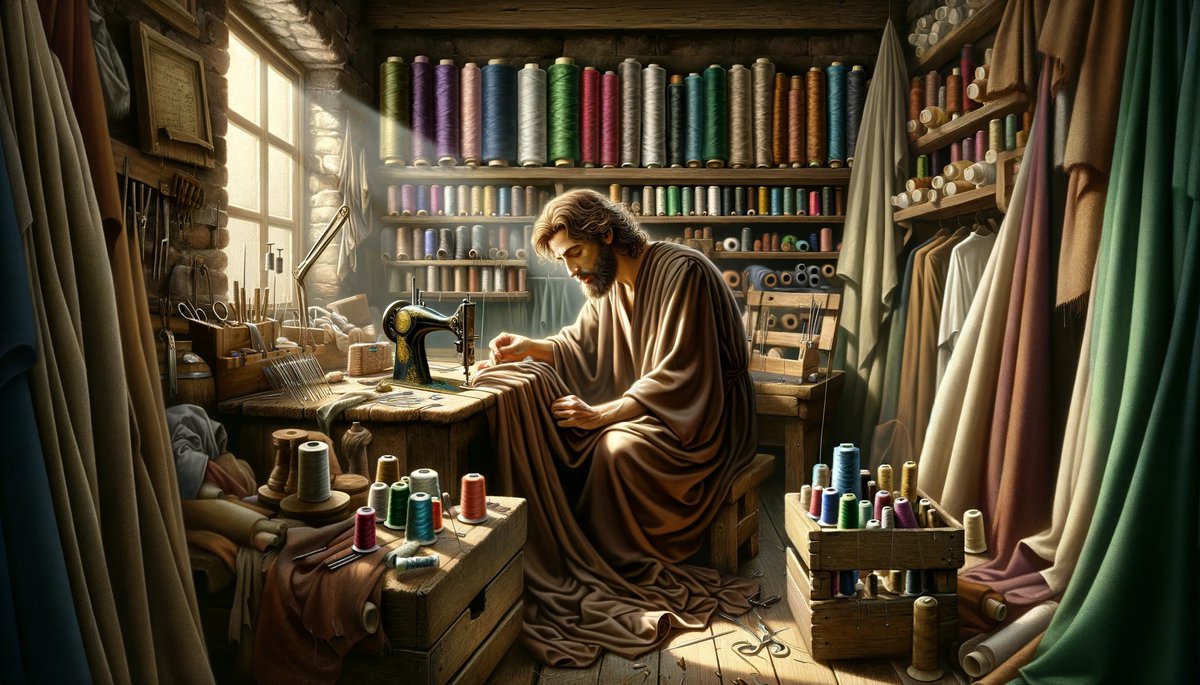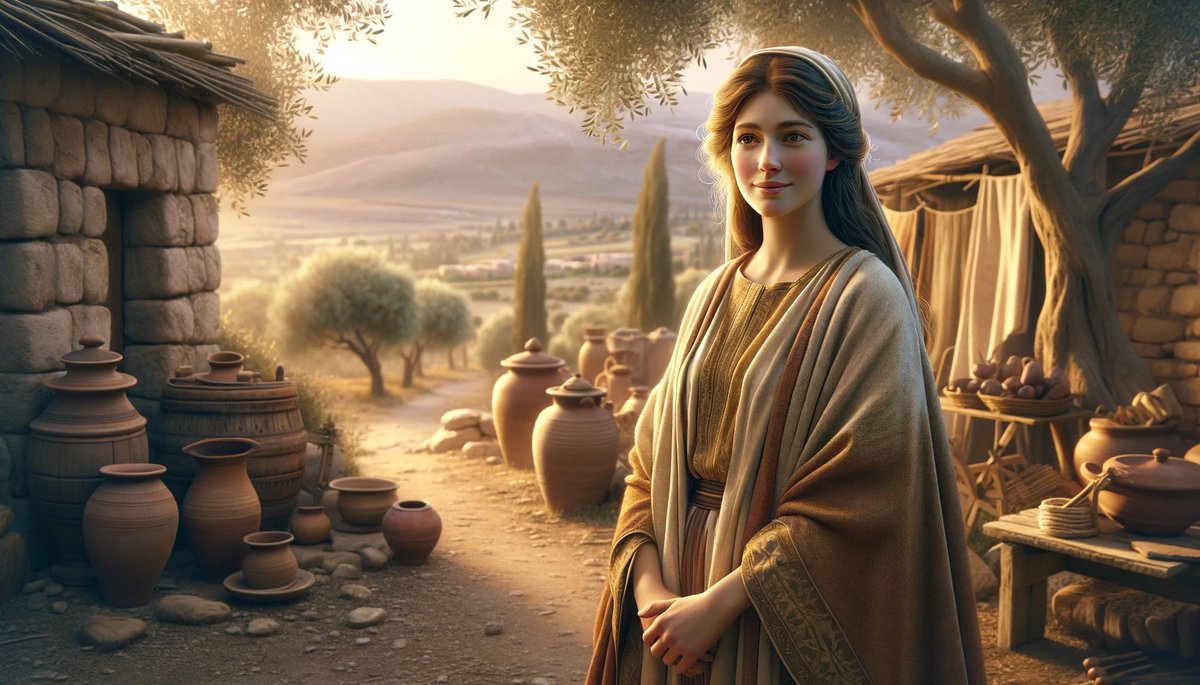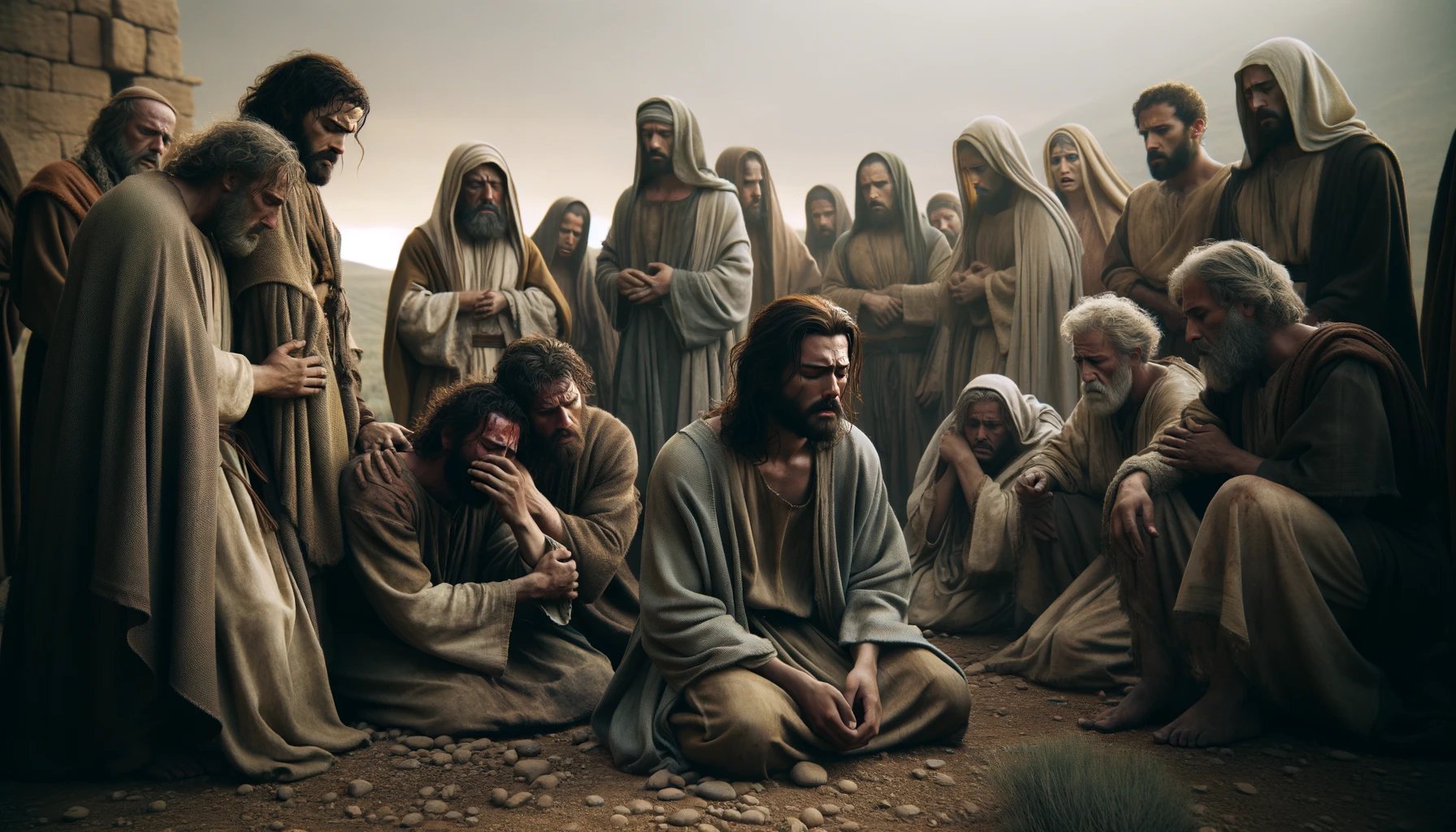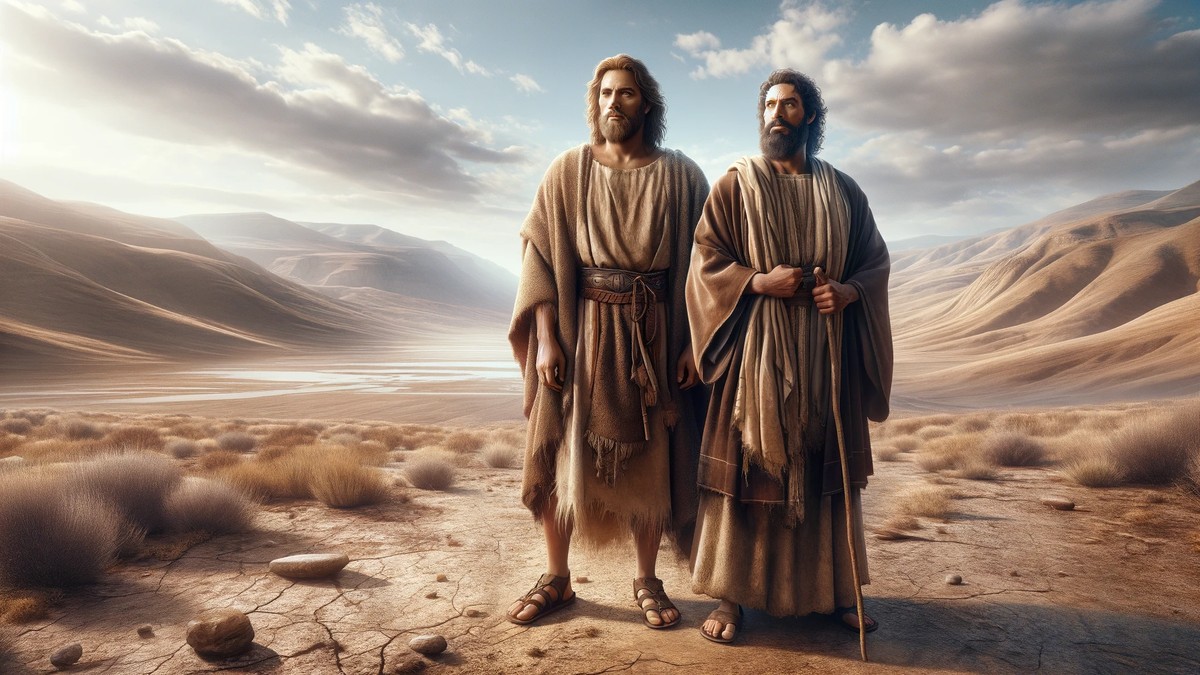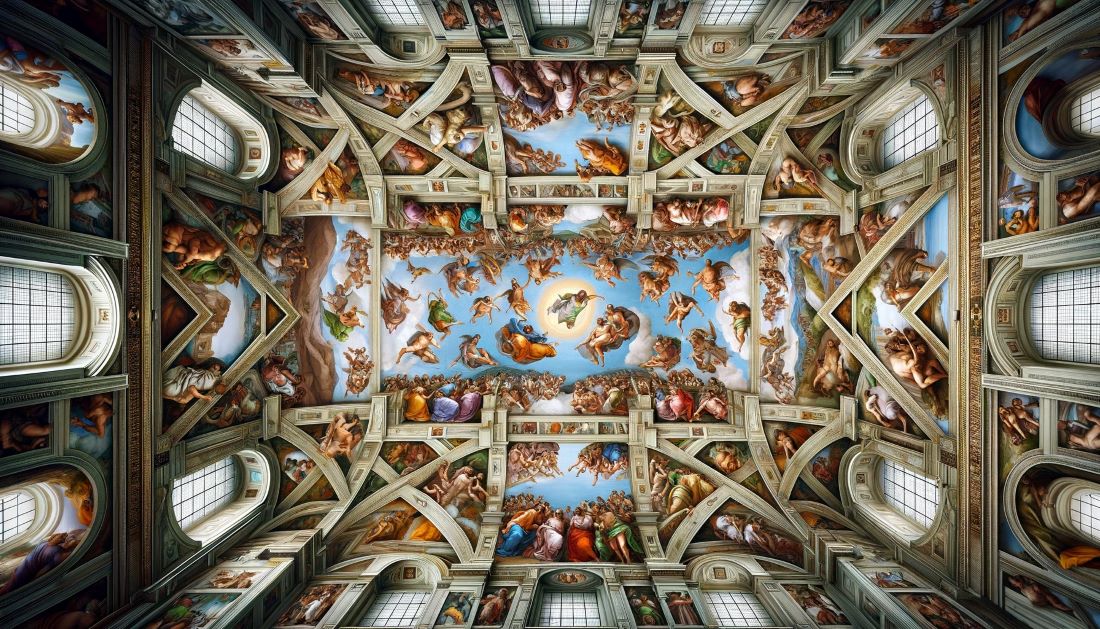Home>Theology and Spirituality>How Is Saint John The Baptist Usually Depicted?


Theology and Spirituality
How Is Saint John The Baptist Usually Depicted?
Published: February 24, 2024
Ericka Andersen, an editor at Christian.net, expertly merges digital strategy with content creation, focusing on faith and societal issues. Her communication skills enhance the platform's engaging narratives, fostering meaningful dialogue on belief's impact on society.
Discover the various depictions of Saint John the Baptist in art and iconography. Explore the theological and spiritual significance of his representations. Gain insight into the symbolism and interpretations.
(Many of the links in this article redirect to a specific reviewed product. Your purchase of these products through affiliate links helps to generate commission for Christian.net, at no extra cost. Learn more)
Table of Contents
Introduction
Saint John the Baptist, a prominent figure in Christianity, holds a revered place in religious art and iconography. Depictions of this influential biblical figure have been a source of inspiration for artists and a subject of fascination for believers and art enthusiasts alike. The portrayal of Saint John the Baptist in various artistic traditions offers a glimpse into the diverse interpretations and cultural significance attributed to this iconic figure.
Throughout history, Saint John the Baptist has been depicted in a multitude of ways, reflecting the evolving artistic styles, religious beliefs, and cultural influences of different time periods and regions. From the solemn and contemplative to the vibrant and dynamic, the visual representations of Saint John the Baptist convey a rich tapestry of symbolism and meaning that transcends mere artistic expression.
In this article, we will delve into the biblical account of Saint John the Baptist, explore the traditional depictions of this revered figure in religious art, unravel the iconography and symbolism associated with his portrayals, examine the variations in depictions across different cultures, and consider modern interpretations of Saint John the Baptist. By delving into these aspects, we aim to gain a deeper understanding of the enduring significance of Saint John the Baptist in both religious and artistic contexts.
Read more: How Did Saint John The Baptist Die
The Biblical Account of Saint John the Baptist
The biblical narrative of Saint John the Baptist unfolds within the context of the New Testament, particularly in the Gospels of Matthew, Mark, Luke, and John. John the Baptist, whose birth was foretold by the angel Gabriel to his father Zechariah, and mother Elizabeth, is portrayed as a pivotal figure heralding the arrival of Jesus Christ, the Messiah. His significance is underscored by his role as the precursor to Jesus, preparing the way for the coming of the Savior through his preaching and baptism.
John's ministry is characterized by his fervent call to repentance and spiritual renewal, urging people to turn away from sin and embrace a life of righteousness. His proclamation in the wilderness, "Repent, for the kingdom of heaven has come near," resonates as a clarion call for spiritual awakening and transformation. This message of repentance and the imminent arrival of the Messiah reverberates throughout his encounters with diverse audiences, including tax collectors, soldiers, and ordinary people seeking guidance.
Central to the biblical narrative is John's baptism of Jesus in the River Jordan, a profound and symbolic act marking the commencement of Jesus' public ministry. This pivotal event underscores John's humility and recognition of Jesus' divine authority, as he declares, "I need to be baptized by you, and do you come to me?" Jesus' baptism by John serves as a powerful testament to the fulfillment of divine prophecy and the establishment of a new covenant.
John's unwavering commitment to his divine calling ultimately leads to his imprisonment and martyrdom, a testament to his unyielding dedication to truth and righteousness. His fearless rebuke of King Herod's unlawful marriage stands as a testament to his unwavering commitment to upholding moral principles, even in the face of persecution and adversity.
The biblical account of Saint John the Baptist portrays him as a prophetic voice, a humble servant, and a harbinger of hope, whose life and ministry exemplify unwavering faith, courage, and devotion to God's purpose. His profound influence on the Christian faith and his enduring legacy as a forerunner to Jesus Christ continue to resonate through the ages, inspiring believers and artists alike to commemorate his pivotal role in the divine narrative.
Traditional Depictions of Saint John the Baptist
The traditional depictions of Saint John the Baptist in religious art have been a subject of profound reverence and artistic exploration. Throughout history, artists have sought to capture the essence of this iconic figure through a myriad of visual representations, each imbued with symbolic significance and spiritual depth. One of the most prevalent and enduring portrayals of Saint John the Baptist is that of the "Baptism of Christ," a theme that has been depicted in countless paintings, sculptures, and religious artifacts.
In these traditional depictions, Saint John the Baptist is often depicted as a solemn and contemplative figure, clad in a camel hair garment, with a rugged and ascetic appearance befitting his life in the wilderness. His gesture of baptizing Jesus in the River Jordan is a central motif, symbolizing the pivotal moment of divine revelation and the initiation of Jesus' earthly ministry. The portrayal of Saint John the Baptist in these artworks conveys a sense of reverence and humility, emphasizing his role as the chosen vessel to herald the arrival of the Messiah.
Furthermore, traditional depictions of Saint John the Baptist often incorporate symbolic elements that convey deeper spiritual meanings. The presence of a lamb, representing Jesus as the sacrificial Lamb of God, is a recurring motif in these artworks, underscoring the profound theological significance of John's proclamation, "Behold the Lamb of God, who takes away the sin of the world." Additionally, the inclusion of a dove, symbolizing the Holy Spirit descending upon Jesus at his baptism, serves as a powerful visual representation of divine affirmation and sanctification.
The artistic representations of Saint John the Baptist also reflect the cultural and stylistic influences of different artistic traditions. From the ethereal and transcendent depictions in Byzantine iconography to the naturalistic and emotive portrayals in Renaissance art, each period and artistic movement has contributed to a diverse tapestry of visual interpretations of this revered biblical figure.
In essence, the traditional depictions of Saint John the Baptist in religious art serve as a testament to the enduring significance of his role in Christian theology and spirituality. Through the masterful brushstrokes of artists and the sculptural finesse of craftsmen, these timeless representations continue to evoke a sense of awe and contemplation, inviting viewers to ponder the profound mysteries of faith and divine revelation encapsulated in the figure of Saint John the Baptist.
Iconography and Symbolism in Depictions
The depictions of Saint John the Baptist in religious art are rich with iconography and symbolism, each element serving as a visual language that communicates profound theological truths and spiritual significance. The iconography associated with Saint John the Baptist encompasses a myriad of symbols that convey his divine mission, his relationship to Jesus Christ, and his enduring influence on Christian spirituality.
One of the central symbols associated with Saint John the Baptist is the depiction of him holding a staff with a cross and a scroll. The staff, often adorned with a cross, signifies John's role as a herald of the coming Messiah and a precursor to Jesus Christ. The scroll, bearing the inscription "Ecce Agnus Dei" (Behold the Lamb of God), encapsulates John's proclamation of Jesus as the sacrificial Lamb who would redeem humanity from sin. This visual representation encapsulates the essence of John's prophetic ministry and his pivotal role in preparing the way for the fulfillment of divine redemption.
The portrayal of Saint John the Baptist with a lamb, either resting at his feet or cradled in his arms, is another potent symbol that permeates artistic depictions. The lamb, a recurring motif in Christian iconography, represents Jesus Christ as the sacrificial Lamb of God, whose atoning sacrifice brings salvation to humanity. By juxtaposing John the Baptist with the lamb, artists convey the profound connection between John's ministry of repentance and the redemptive mission of Jesus, underscoring the continuity between the Old Testament prophecies and their fulfillment in the New Testament.
Additionally, the presence of a halo or nimbus surrounding the head of Saint John the Baptist signifies his sanctity and divine favor. This radiant halo, often adorned with a cross or inscribed with the words "Agnus Dei" (Lamb of God), serves as a visual affirmation of John's exalted status as a holy and anointed servant of God. The halo not only illuminates the spiritual aura surrounding John but also accentuates his pivotal role in heralding the dawn of a new era of grace and salvation through the coming of Jesus Christ.
Moreover, the depiction of Saint John the Baptist in the wilderness, accompanied by a reed cross or a staff entwined with a cross, serves as a poignant reminder of his ascetic lifestyle and his unwavering commitment to his prophetic mission. The rugged and austere portrayal of John amidst the wilderness underscores his detachment from worldly comforts and his singular focus on preparing the hearts of the people for the imminent arrival of the Messiah.
In essence, the iconography and symbolism in depictions of Saint John the Baptist serve as a visual tapestry of profound theological truths and spiritual insights, inviting viewers to contemplate the timeless significance of John's prophetic ministry and his enduring legacy as a herald of divine redemption. Through these potent symbols, artists convey the transcendent mysteries of faith and the transformative power of divine grace encapsulated in the figure of Saint John the Baptist.
Variations in Depictions Across Different Cultures
The depictions of Saint John the Baptist across different cultures exhibit a fascinating array of variations, reflecting the diverse artistic traditions, religious interpretations, and cultural nuances prevalent in various regions. From the ethereal and otherworldly representations in Byzantine iconography to the naturalistic and emotive portrayals in Renaissance art, the visual interpretations of Saint John the Baptist are imbued with distinct cultural influences that enrich the tapestry of his iconic imagery.
In Byzantine art, Saint John the Baptist is often depicted with a sense of otherworldly transcendence, characterized by elongated forms, solemn expressions, and a spiritual luminosity that conveys a sense of divine radiance. The Byzantine depictions emphasize the sacred and mystical nature of John's prophetic ministry, portraying him as a celestial figure endowed with an aura of sanctity and spiritual authority. The use of gold leaf and rich, vibrant colors in Byzantine icons further accentuates the transcendent quality of these representations, evoking a sense of reverence and awe.
In contrast, the Renaissance period witnessed a shift towards naturalism and humanism, leading to a more emotive and lifelike portrayal of Saint John the Baptist. Artists such as Leonardo da Vinci and Caravaggio infused their depictions of John with a sense of emotional depth and psychological realism, capturing the nuances of human expression and the complexities of the human experience. The Renaissance renditions of Saint John the Baptist often depict him in dynamic poses, engaging with the viewer on a deeply personal and human level, thus emphasizing the profound humanity of this revered biblical figure.
Furthermore, in Eastern Orthodox traditions, Saint John the Baptist is venerated as a central figure, with numerous icons and frescoes adorning churches and monasteries. The depictions in Eastern Orthodox iconography emphasize John's role as the Forerunner, the voice crying out in the wilderness, and the baptizer of Christ, conveying a sense of spiritual urgency and divine revelation. The stylized and symbolic elements in Eastern Orthodox icons, such as the use of intricate patterns and ornate vestments, contribute to a visually striking representation of Saint John the Baptist that resonates deeply within the Eastern Christian tradition.
In Latin American art, Saint John the Baptist is often depicted in vibrant and colorful renditions, reflecting the cultural richness and religious fervor prevalent in the region. The depictions of John in Latin American art often incorporate indigenous influences, blending Christian iconography with indigenous symbolism and artistic motifs. This fusion of cultural elements results in visually captivating representations of Saint John the Baptist that resonate with the spiritual sensibilities of the local communities, fostering a profound sense of cultural and religious identity.
In essence, the variations in depictions of Saint John the Baptist across different cultures offer a compelling testament to the enduring impact of his figure on global artistic traditions. The diverse interpretations and cultural adaptations of his imagery serve as a testament to the universal resonance of his message and the enduring relevance of his prophetic ministry across diverse cultural landscapes.
Read more: Who Is Saint John The Baptist
Modern Interpretations of Saint John the Baptist
In contemporary art, the portrayal of Saint John the Baptist continues to evolve, reflecting the dynamic interplay between tradition and innovation, spirituality and cultural relevance. Modern interpretations of Saint John the Baptist encompass a diverse range of artistic expressions, from traditional mediums to avant-garde explorations, each offering a unique perspective on the enduring significance of this iconic biblical figure.
In the realm of visual arts, contemporary artists have reimagined the portrayal of Saint John the Baptist through innovative stylistic approaches and conceptual frameworks. The traditional themes of baptism, repentance, and divine revelation are reinterpreted through a modern lens, incorporating contemporary symbols, visual metaphors, and socio-political commentary. This fusion of traditional iconography with contemporary sensibilities results in visually arresting representations that resonate with audiences in a rapidly changing world.
Moreover, the depiction of Saint John the Baptist in contemporary art often extends beyond traditional two-dimensional forms, embracing multimedia installations, performance art, and interactive experiences. Artists harness the power of technology and immersive storytelling to engage viewers in thought-provoking narratives that invite introspection and dialogue. Through these innovative artistic endeavors, Saint John the Baptist becomes a catalyst for exploring timeless themes of spirituality, social justice, and the human condition in a modern context.
Furthermore, contemporary interpretations of Saint John the Baptist extend beyond the confines of traditional religious art, permeating popular culture, fashion, and digital media. The iconic imagery of Saint John the Baptist finds resonance in fashion design, where his rugged asceticism and spiritual symbolism inspire haute couture and avant-garde fashion collections. Additionally, digital artists and graphic designers incorporate elements of Saint John the Baptist's iconography into visually stunning digital artworks, infusing his timeless presence into the digital realm.
In the realm of theology and spirituality, modern interpretations of Saint John the Baptist continue to inspire theological reflections, sermons, and scholarly discourse. The figure of John the Baptist serves as a compelling archetype for exploring themes of prophetic witness, moral courage, and the call to spiritual renewal in contemporary religious contexts. His unwavering commitment to truth and justice resonates as a timeless example for individuals and communities grappling with ethical dilemmas and societal challenges.
In essence, the modern interpretations of Saint John the Baptist reflect a dynamic and multifaceted engagement with his enduring legacy, transcending traditional boundaries and resonating with contemporary audiences. Through the convergence of artistic innovation, cultural relevance, and spiritual introspection, Saint John the Baptist continues to inspire and captivate, offering a timeless beacon of hope and renewal in a rapidly changing world.
Conclusion
The enduring legacy of Saint John the Baptist transcends the boundaries of time and culture, permeating the realms of art, spirituality, and human consciousness. From the solemn and contemplative depictions in traditional religious art to the vibrant and innovative interpretations in contemporary expressions, the figure of Saint John the Baptist continues to captivate and inspire individuals across diverse landscapes.
The biblical account of Saint John the Baptist, as a prophetic voice heralding the arrival of Jesus Christ, resonates as a timeless testament to the transformative power of faith and the enduring call to spiritual renewal. His unwavering commitment to truth, his fearless advocacy for righteousness, and his humility in recognizing the divine authority of Jesus exemplify the virtues of prophetic witness and moral courage that continue to resonate with believers and seekers of truth.
The traditional depictions of Saint John the Baptist in religious art serve as a visual tapestry of profound theological truths and spiritual insights, inviting viewers to contemplate the timeless significance of John's prophetic ministry and his enduring legacy as a herald of divine redemption. The rich iconography and symbolism associated with his portrayals convey the transcendent mysteries of faith and the transformative power of divine grace encapsulated in the figure of Saint John the Baptist.
Moreover, the variations in depictions of Saint John the Baptist across different cultures offer a compelling testament to the enduring impact of his figure on global artistic traditions. The diverse interpretations and cultural adaptations of his imagery serve as a testament to the universal resonance of his message and the enduring relevance of his prophetic ministry across diverse cultural landscapes.
In contemporary art, the portrayal of Saint John the Baptist continues to evolve, reflecting the dynamic interplay between tradition and innovation, spirituality and cultural relevance. Modern interpretations of Saint John the Baptist encompass a diverse range of artistic expressions, from traditional mediums to avant-garde explorations, each offering a unique perspective on the enduring significance of this iconic biblical figure.
In essence, the figure of Saint John the Baptist stands as a timeless symbol of hope, renewal, and spiritual awakening, transcending the confines of historical epochs and cultural boundaries. His legacy endures as a testament to the enduring power of faith, the transformative impact of divine revelation, and the universal call to embrace righteousness and compassion. Through the timeless imagery and profound symbolism associated with Saint John the Baptist, individuals are invited to embark on a contemplative journey, exploring the depths of faith, the resilience of the human spirit, and the enduring promise of divine grace.

